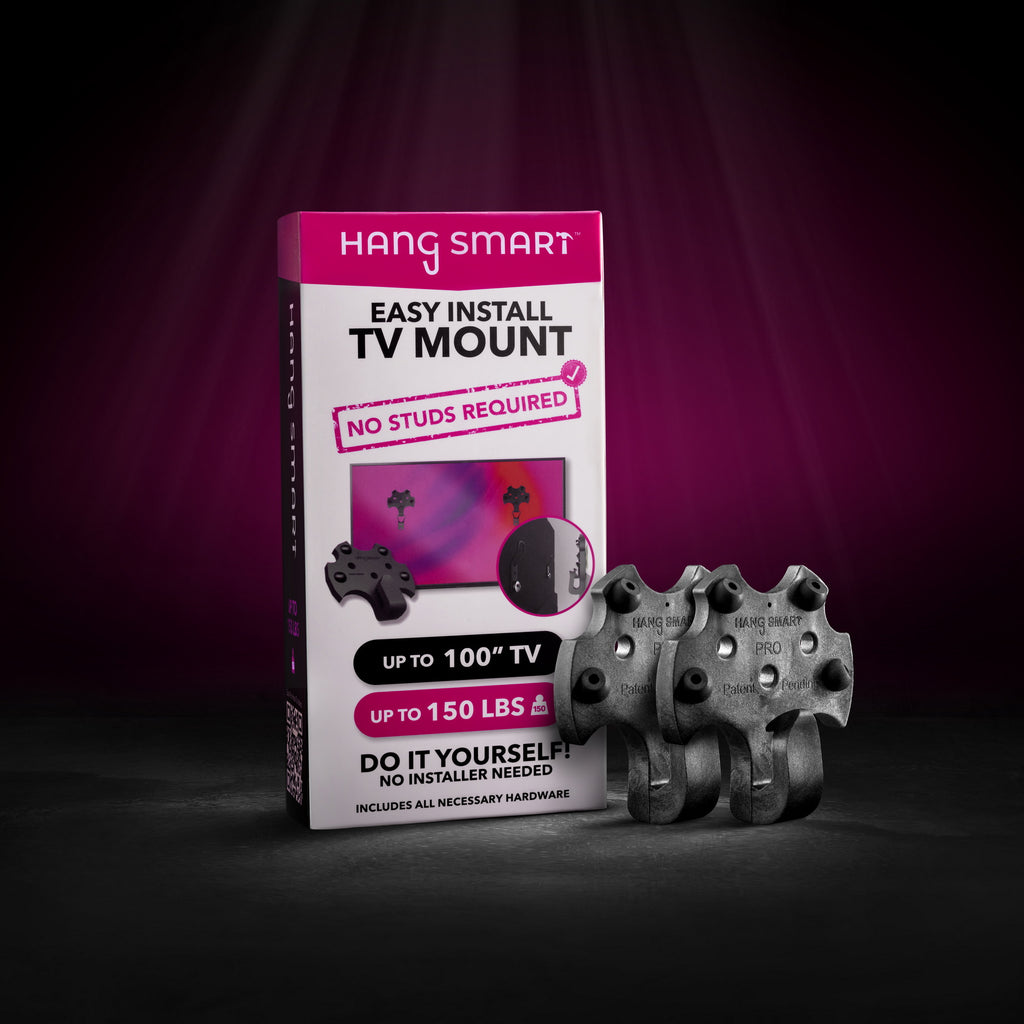
Can You Mount a TV Without Studs? Here's How It's Done.
Wall-mounting your TV is one of the cleanest, most space-saving ways to upgrade your living room or home theater. But what if your wall doesn’t have studs where you need them? Or worse, what if you're living in an apartment and drilling into studs isn’t an option? Good news: mounting a TV without studs is not only possible, it's safe and surprisingly simple — if you do it the right way.
Why People Think Studs Are Necessary
Traditionally, studs have been the go-to for mounting TVs because they provide solid support behind the drywall. Drywall on its own isn’t built to handle heavy loads, which is why mounting directly into it without any reinforcement has always been a risk.
But here’s the thing: innovations in wall mounting technology have made it completely feasible to hang TVs on drywall without ever having to find a stud. The key lies in using systems specifically engineered for this kind of setup.
Enter the HangSmart No-Stud TV Mount
If you haven’t heard of it yet, the HangSmart TV Mount is a game-changer. Designed specifically for drywall-only installations, it allows you to securely hang TVs up to 100" and 150 lbs without drilling into a single stud. That’s not an exaggeration — it’s built with a clever weight distribution system that spreads the load evenly, eliminating the stress points that typically lead to failure.
The best part? You don’t need to be an expert or hire someone to install it. With just a few basic steps, most users get their TVs mounted in under 10 minutes.

Tools You Don’t Need Anymore
No stud finder. No power drill. No anchors into unpredictable framing. You don’t even need to make a mess. With mounts like HangSmart, it really is a peel, press, and hang process — plus a bit of measuring, of course.
But Is It Safe?
This is usually the first question people ask, and rightly so. When done using a system designed for studless installs, yes, it's completely safe. The HangSmart system, for example, has undergone rigorous testing and holds up to 150 lbs when properly installed on standard drywall. The key is using mounts that have been designed and stress-tested for this exact scenario — don’t try to improvise with regular mounts and drywall anchors.
Perfect for Renters and Minimalists
Studless mounts are perfect for renters who want the wall-mounted look without breaking lease agreements. They're also ideal for people who want a clean aesthetic without committing to major holes or patchwork later.
How to Mount Your TV Without Studs
Here’s a simple step-by-step guide:
-
Choose the right mount: Look for no-stud options like HangSmart that are engineered for drywall installs.
-
Measure your space: Use a leveling tool and measuring tape to decide your ideal height.
-
Use a mounting guide: Many studless mounts come with a paper template or color-coded guide for easy leveling.
-
Mark and install: Follow the instructions to mark your placement and install the mount. Typically, it's a matter of pushing a few engineered nails or hooks into the drywall.
-
Hang your TV: Carefully place your TV on the mount. Double-check alignment and you’re done.
Final Thoughts
Mounting a TV without studs used to be a risky workaround. Now, it’s a smart design choice. As long as you’re using a system like HangSmart that’s purpose-built for the job, there’s no reason you can’t enjoy a beautiful, stud-free TV setup.
Looking to upgrade your space? Check out the HangSmart No-Stud TV Mount — and hang with confidence.
Interested to see the test in action? Check out the test results Here:
INTRODUCTION
360° Product Testing has been retained to perform 24-hour, approximately 190-pound,1 load tests using supplied Hang Smart TV devices (pictured at right) mounted on Drywall, Cement and Brick vertical surfaces. At the conclusion of the 24-hour test period, the mounts and mounting surface are evaluated for signs of permanent deformation or pullout.
Setup
Hang Smart TV Mounts were installed in pairs on Drywall, Cement and Brick vertical surfaces using provided measurement tools and hardware (Figure 1) along with a screwdriver and hammer drill.
An initial drywall setup test was conducted using a weighted steel cable run directly through the mount hooks. However, to better emulate a hung flat panel TV, the method was modified to include the mounting loops attached to a spar of wood mimicking a TV backing, and weighting was then attached to the wood.
For the brick and cement tests, bricks and cement blocks were first secured and reinforced to support the required testing load. These tests also utilized the same weighted spar of wood.
The following presents 360° Product Testing’s findings:

Drywall Test
The Hang Smart TV Mount was attached to drywall and subjected to a 191-pound load for 24-hours. The drywall mounted Hang Smart pair sustained the load for 24-hours without observed pullout or deformation.
1 Applied load, i.e., tested weight, is approximately 27% over rated load capacity of 150-pounds.
Figure 1: Mounted on Drywall Using Included Measurement Tool

Cement Test
The Hang Smart TV Mount was attached to cement blocks and subjected to a 190-pound load for 24-hours. The cement mounted Hang Smart pair sustained the load for 24-hours without observed pullout or deformation.
Figure 2: Mounted on cement block under tension

Brick Test
The Hang Smart TV Mount was attached to reinforced bricks and subjected to a 191-pound load for 24 hours. The brick mounted Hang Smart pair sustained the load for 24-hours without observed pullout or deformation.
Figure 3: Mounted on brick under tension
Reviewed By: DCW RNS
360° Product Testing • 4 Executive Plaza • Yonkers, New York 10701 • Toll-Free (844) 360 - TEST

Who wouldn't want the easiest way to install their TV while saving money from having to hire a handyman?!?
Shop HangSmart Today!
Check Out How It Works!
Thank you for being a fan!



